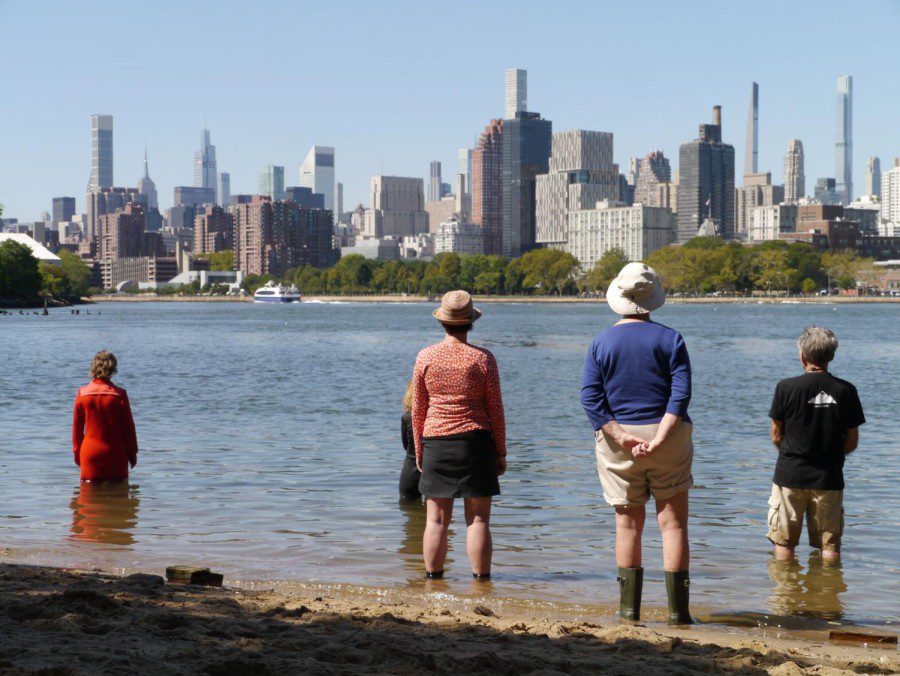Performance art in New York waters raises awareness about rising sea levels
Sarah Cameron Sunde’s “36.5 / A Durational Performance with the Sea” is a contemplative observation of climate change.
“A Durational Performance with the Sea” is the finale in a series by performance artist Sarah Cameron Sunde. The performance is open to public participation and raises awareness about the effects of rising sea levels. (Polina Belova for WSN)
September 26, 2022
One of the goals of performance arts has always been to communicate truths through direct interaction with the audience. However, when it comes to ecological topics, a performer needs to cooperate not only with people but with the environment itself. Sarah Cameron Sunde’s “36.5 / A Durational Performance with the Sea” — in which the artist stood in the New York–New Jersey Harbor Estuary for a full tidal cycle — becomes a realistic account of what will happen to our bodies when the time comes to merge with nature. Sunde lets the sea gradually absorb her as she searches for a profound dialogue between the body of water and the human body. What does the sea have to say, and how should we listen to its answers?
From 7:27 a.m. to 8:06 p.m. on Sept. 14, Sarah Cameron Sunde presented the last work in her 36.5 series. The series had nine site-specific performances and video artworks depicting Sunde standing on the shore during a full tidal cycle. They start with her waiting for the water to first hit her feet; the water gradually rises to cover her whole body until only her nose and eyes are left above the surface.
What began in 2013 as a mere artistic action has grown into a complex artwork involving hundreds of people around the globe. In the aftermath of Hurricane Sandy in 2012, Sunde became concerned about the possible effects of rising sea levels on New York City. Her voluntary, motionless immersion in water serves as a demonstrative response. During this nine-year period, Sunde made creative contributions in various parts of the world where flooding is an annual problem: Maine, California, New York in the U.S., Mexico, the Netherlands, Bangladesh, Brazil, Kenya, and New Zealand. Only her first performance was done in solitude — while her example was willingly followed by the indigenous stewards of the lands, who then became an inseparable part of the performance like any other improvisational spectator-participants.
By inviting anyone to join her, Sunde subverts the usual boundary between spectators and art. NYU students who attended the final performance were forced to rethink their roles as spectators upon noticing other attendees immersing themselves alongside Sunde.
“I bumped into another student, we started talking and then asked ourselves, ‘Should we be talking now or should we be doing the same practice as the people in the water,”’ NYU Tisch sophomore Aidan La Poche said.
La Poche points to the idea that the spectator should attempt to mentally plunge into the water, making the performance a contemplative experience instead of a social one.
“A lot of times performances are prioritized towards humanity’s social issues but this was a piece about the environment and not person-to-person interaction,” La Poche said.
CAS senior Phoebe Goldman shared quite the opposite vision of the performance, instead gaining a highly social experience out of it.
“I am not sure that this was not about person-to-person connection,” Goldman said. “The performance itself, to that extent, was about people being overrun by the water. But the structure of where it was performed and how long the people were around there was really about getting people to talk about it, to enjoy such a creative communal space where you can have both a chat and a snack.”
For those who were part of the spectator-participant group, a big part of the process was meditation and achieving a soothing connection with nature. Tisch junior Rachel Moe joined Sunde and stood in the water for an hour and a half.
“It made me process what was actually going on, as everyone was still and you were not allowed to move or speak,” Moe said. “I really struggle sometimes with making or looking at art as it is so subtle, so it was a good challenge for me. The whole experience was just a very meditative one. I really appreciated it.”
The introspective and liberating state of participants’ minds along with their still bodies finally brings us to a popular environmental discourse: the politics of doing nothing, as opposed to the politics of doing something. Sunde’s piece is about presence, nothingness, and submission, not hands-on civic engagement.
“In a sense, in combating climate change, the thing that we need the most is to make everyone stop,” Goldman said. “Doing things is what causes climate change and doing different things causes climate change in different amounts, but the only thing that doesn’t provoke climate change is not doing things.”
CAS junior Ryan Kosick presented a more fatalistic view.
“We are always worried about our self-preservation,” Kosick said. “It’s not about the environment, it’s about saving ourselves, which is why I like the fact that Sarah is not doing anything in the performance. She is not only being submissive to nature but almost killing herself to an extent.”
Even though this nine-year durational project has concluded, you still have the opportunity to listen to Sunde talk more about “36.5” on Oct. 6 at 6:00 p.m. at a celebratory academic event at Gardner Commons in Shimkin Hall. This talk will be followed by a screening of video artworks on the outside wall of Bobst Library, curated by NYU dean for the humanities Una Chaudhuri.
Contact Polina Belova at [email protected].























































































































































